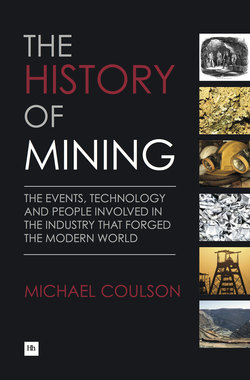Читать книгу The History of Mining - Michael Coulson - Страница 38
На сайте Литреса книга снята с продажи.
6. Spain
ОглавлениеWhilst the Spanish were involved in acquiring gold from their South American conquests, at home mining of gold continued along with the mining of other minerals, largely from historic mining districts, some of which had been active for several thousand years. Permission to mine coal in the Seville region at Villeneuva del Rio was given by the Crown in 1621. Initially individual miners worked the coal seams but in 1740 the Royal Artillery Petty Officers of Seville took over the mines as rising industrialisation and therefore rising demand led to a need for more integrated and efficient mining practices. After further changes of control in the 19th century, the mines were nationalised in 1969.
The iron ore mines of Viscaya in the north at Las Encartaciones were worked throughout the Middle Ages, as were the iron ore deposits of the Valle del Sabero in Leon in the north. The gold mines at Rodalquila in Almeria and the iron mines of Ojos Negros in Aragon were other ancient operations which were mined right through from the medieval period to the modern era, as were the Almaden mercury deposits in Castile-la Mancha, the salt mines of Iman in Guadalajara, and the coal mines of the Valle de Sabero in Leon. Many of these areas crop up again later when the Industrial Revolution led to a surge in demand for minerals throughout Europe.
Particularly unusual was the Almadèn mercury mine, which is believed to have operated for an unbroken two millennia, although there is a view that it may have been exploited as long ago as the 6th millennium BC. The deposit contained cinnabar, from which liquid mercury was produced by a reduction process. The first recorded reference to Almadèn was in the 5th century BC, and during the Roman occupation of Spain the mines were extensively exploited. With the fall of the Roman Empire there was no further reference to mercury mining in Spain until 711, when the Arabs overran the country and operated the mines until their departure in the 12th century. The mine then came under the control of the Spanish Crown. In ancient times mercury was used as an elixir of life and even as a treatment for broken bones, later it was used as an ointment and in cosmetics. These are all uses that, bearing in mind the great toxicity of the metal, seem curious to modern minds.
The conquest by Spain of Latin America in the 16th and 17th centuries led to a massive boost in Almadèn’s fortunes as the discovery of particularly silver, but also gold, deposits led to a major increase in demand for mercury as an amalgam to separate precious metals from their ore. Although presenting grave health risks to workers who operated the treatment process, the demand for Almadèn’s mercury in Spain’s New World colonies rose materially. By the 18th century, local mercury was being used to treat Latin American precious metals but Almadèn continued to prosper on the back of Spanish demand, indeed to such an extent that the Spanish government used the mine as a guarantee in receiving loans from, in particular, German financiers in the 16th and 17th centuries. Later the Rothschilds made similar loans to Spain backed by Almadèn.
With the advance of science, mercury found new uses in inventions such as thermometers, barometers and even in dentistry for fillings. In the 20th century it also was used in a wide range of chemical products and munitions. More recently its use in many of these areas has been phased out as governments have become concerned about its safety, but ironically the development of energy-saving fluorescent light bulbs has led to a recovery in mercury use.
As to Almadèn, it prospered in the 1940s when production reached over 80,000 flasks per year but things became more difficult after the Second World War and the mine was re-organised by the Spanish government in the 1980s, only for it to close in the early years of the new millennium as mercury demand fell away. It is calculated that over history the Almadèn mine has produced around one-third of all the mercury ever produced, and the Spanish government is seeking UNESCO World Heritage Site status for the mine.
